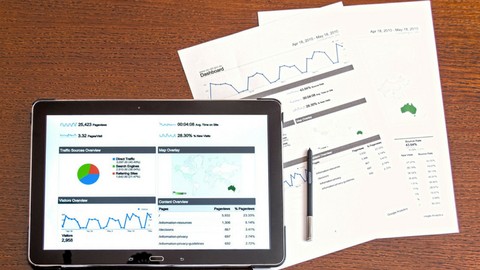
Python Data Analysis & Visualization Bootcamp(Cybersecurity)
Python Data Analysis & Visualization Bootcamp(Cybersecurity), available at $69.99, has an average rating of 4.25, with 83 lectures, based on 3667 reviews, and has 8721 subscribers.
You will learn about Perform Data Analytics seamlessly and smartly This course is ideal for individuals who are Beginner Python Data Analyst should take up this course. or Intermediate Python Data Analyst should take up this course. It is particularly useful for Beginner Python Data Analyst should take up this course. or Intermediate Python Data Analyst should take up this course.
Enroll now: Python Data Analysis & Visualization Bootcamp(Cybersecurity)
Summary
Title: Python Data Analysis & Visualization Bootcamp(Cybersecurity)
Price: $69.99
Average Rating: 4.25
Number of Lectures: 83
Number of Published Lectures: 45
Number of Curriculum Items: 83
Number of Published Curriculum Objects: 45
Original Price: $22.99
Quality Status: approved
Status: Live
What You Will Learn
- Perform Data Analytics seamlessly and smartly
Who Should Attend
- Beginner Python Data Analyst should take up this course.
- Intermediate Python Data Analyst should take up this course.
Target Audiences
- Beginner Python Data Analyst should take up this course.
- Intermediate Python Data Analyst should take up this course.
Welcome to Data Analysis Analytics Bootcamp content powered by TakenMind.
Are you interested to learn how zetabytes of data are processed by top tech companies to analyse data inorder to boost their business growth? Well, for a beginner you are at the right place and this is the most probably the right time for you to learn this.
The average data scientist today earns $123,000 a year, according to Indeed research. But the operating term here is “today,” since data science has paid increasing dividends since it really burst into business consciousness in recent years.
This course has its base on financial Analysis and the following concepts are covered:
-
Python Fundamentals
-
Pandas for Efficient Data Analysis
-
NumPy for High Speed Numerical Processing
-
Matplotlib for Data Visualization
-
Pandas for Data Manipulation and Analysis
-
Seaborn Data Visualization
-
Worked-up examples.
Learn how to analyze data using Python. This course will take you from the basics of Python to exploring many different types of data. You will learn how to prepare data for analysis, perform simple statistical analyses, create meaningful data visualizations, predict future trends from data, and more!
You will learn how to:
-
Import data sets
-
Clean and prepare data for analysis
-
Manipulate pandas DataFrame
-
Summarize data
-
Build machine learning models using scikit-learn
-
Build data pipelines
Data Analysis with Python is delivered through lecture, hands-on labs, and assignments. It includes following parts:
-
Data Analysis libraries: will learn to use Pandas DataFrames, Numpy multi-dimentional arrays, and SciPy libraries to work with a various datasets. We will introduce you to pandas, an open-source library, and we will use it to load, manipulate, analyze, and visualize cool datasets. Then we will introduce you to another open-source library, scikit-learn, and we will use some of its machine learning algorithms to build smart models and make cool predictions.
Course Curriculum
Chapter 1: Setup and Jupyter Environment (Python 3)
Lecture 1: Introduction to the Study Kit
Lecture 2: #1 Downloading Setup and Installation
Lecture 3: #2 Installing Work Environment – Jupyter Notebook
Lecture 4: #3 Exploring Jupyter Notebook functionalities
Lecture 5: #4 Python Package Index – Using Command line interface and Jupyter Notebook
Chapter 2: Data Manipulation with Numpy (Python 3)
Lecture 1: #1 Getting Started – Numpy Arrays (Numerical Python)
Lecture 2: #2 Scalar Operations on Numpy Arrays
Lecture 3: #3 Array Indexes – Part 1
Lecture 4: #4 Array Indexes in Multi-Dimensional Numpy Arrays
Lecture 5: #5 – Premium Array Operations
Lecture 6: #6 Saving And Loading Arrays To External Memory
Lecture 7: #7 Statistical Processing And Sketching Graphs
Lecture 8: #8 Conditional Clauses And Boolean Operation
Chapter 3: Data Manipulation with Pandas (Python 3)
Lecture 1: #1 Getting Started with Series
Lecture 2: #2 Introduction to DataFrames in Pandas
Lecture 3: #3 Learning to access elements with indexes
Lecture 4: #4 – Re-indexing in pandas Series and Dataframes
Lecture 5: #5 – Dropping values from Series and DataFrames
Lecture 6: #6 – Handling Null or NAN values in pandas
Lecture 7: #7 Selecting and Modifying entries in Pandas
Lecture 8: #8 Coordinate and Regulate data in Series and Dataframes
Lecture 9: #9 – Ranking and Sorting in Series
Lecture 10: #10 Statistical Data Analysis and Graphs in Pandas
Chapter 4: Starting with File Operations (Python 3)
Lecture 1: #1 File Operations – Dataframes And Csv
Lecture 2: #2 Import Data From Excel File
Chapter 5: Data Analysis and Methodologies – Learn to perform Operations on datasets (Py 3)
Lecture 1: #1 Pandas – Merging along columns in DataFrames
Lecture 2: #2 Concatenation of Arrays, Series and Dataframes
Lecture 3: #3 Combining values of a DataFrame or Series
Lecture 4: #4 Reshaping Datasets – Series and Dataframe
Lecture 5: #5 Pivot Tables
Lecture 6: #6 Duplicates Analysis in dataset
Lecture 7: #7 Mapping in DataFrame
Lecture 8: #8 Replace values in Series
Lecture 9: #9 Renaming Indexes in DataFrame
Lecture 10: #10 Observation, Filtering and Basic Analysis
Chapter 6: Data Visualization
Lecture 1: Data Visualization and Introduction to Seaborn Visualization Library
Lecture 2: Histogram Visualization in seaborn
Lecture 3: Seaborn Kernel Density Estimation (KDE) Plot on Univariates
Lecture 4: Seaborn KDE Plot for multivariates
Lecture 5: Plotting multiple charts with seaborn
Lecture 6: Box Plot Visualization
Lecture 7: Regression Plots with seaborn
Lecture 8: Violin plot Visualization
Lecture 9: Heat Maps Visualization
Lecture 10: Cluster Map Visualization
Instructors
-
Siranjeevi Dheenadhayalan
Security and Enterprise Research Group
Rating Distribution
- 1 stars: 112 votes
- 2 stars: 91 votes
- 3 stars: 449 votes
- 4 stars: 756 votes
- 5 stars: 2259 votes
Frequently Asked Questions
How long do I have access to the course materials?
You can view and review the lecture materials indefinitely, like an on-demand channel.
Can I take my courses with me wherever I go?
Definitely! If you have an internet connection, courses on Udemy are available on any device at any time. If you don’t have an internet connection, some instructors also let their students download course lectures. That’s up to the instructor though, so make sure you get on their good side!
You may also like
- Best Video Editing Courses to Learn in March 2025
- Best Music Production Courses to Learn in March 2025
- Best Animation Courses to Learn in March 2025
- Best Digital Illustration Courses to Learn in March 2025
- Best Renewable Energy Courses to Learn in March 2025
- Best Sustainable Living Courses to Learn in March 2025
- Best Ethical AI Courses to Learn in March 2025
- Best Cybersecurity Fundamentals Courses to Learn in March 2025
- Best Smart Home Technology Courses to Learn in March 2025
- Best Holistic Health Courses to Learn in March 2025
- Best Nutrition And Diet Planning Courses to Learn in March 2025
- Best Yoga Instruction Courses to Learn in March 2025
- Best Stress Management Courses to Learn in March 2025
- Best Mindfulness Meditation Courses to Learn in March 2025
- Best Life Coaching Courses to Learn in March 2025
- Best Career Development Courses to Learn in March 2025
- Best Relationship Building Courses to Learn in March 2025
- Best Parenting Skills Courses to Learn in March 2025
- Best Home Improvement Courses to Learn in March 2025
- Best Gardening Courses to Learn in March 2025






















